"We're so very pleased with everything and the bed is wonderfully comfortable and the perfect height." Mr Bentley, Montgomeryshire
See more about what our clients have to say...
Click to View Products by CategoryConception and design of a hand carved oak chapel bed
Historical background.
Not many English houses have a chapel. Well, certainly not these days! However, go back seven centuries and the picture is a little different. For a building built by, or belonging to someone of some status, a chapel was 'de rigueur'. So, many great houses incorporated a room for prayer and these could take the form of a small space with altar (Hever Castle), to grand affairs, embellished with the finest carved oak, painted ceilings and even its own knave with pew type seating (Ightham Mote).
In our clients particular case, the chapel in their English manor house has a floor space of approximately 25 square metres, with a stone altar (not believed original), and a tall 'Perpendicular period' stone mullioned window, with diamond leaded glass. The west end of the room has now been equipped with an oak framed mezzanine (recently installed), housing an en-suite bathroom and reached via a metal spiral staircase in the corner.
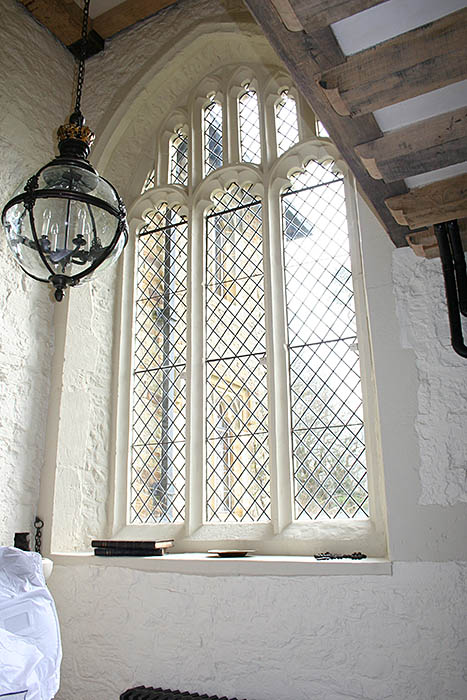
The chapel's tall Perpendicular period stone mullioned window. Top right you can see the edge of the oak framed mezzanine, housing the en-suite bathroom.
As a temporary measure, our client had a French style bed which, although rather nice, was completely out of place in the Medieval room and too narrow, as can be seen in the photo below.
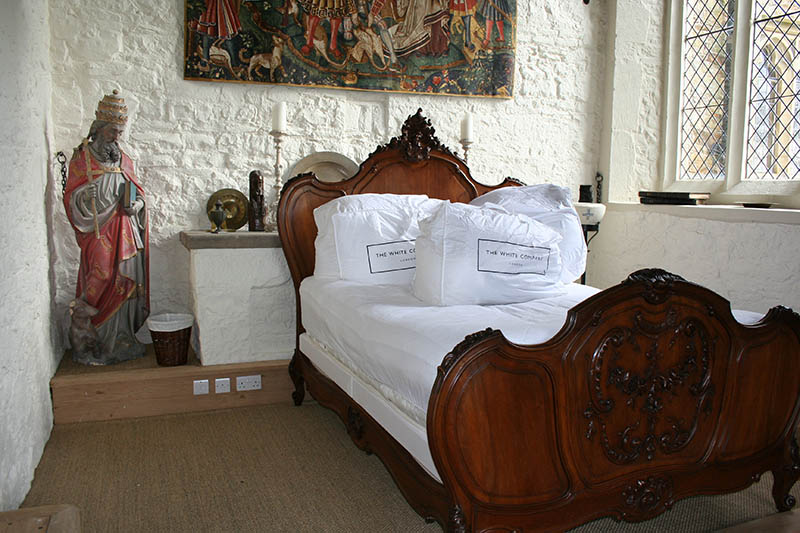
The brief, subsequent discussions and initial design.
The brief from our client was, well pretty brief. As is often the case!
What he did tell us was that he wanted a 'pencil' style bed, i.e. four posts but with no tester ceiling and that he wanted still to be able to see the top of the altar and the display of antique artifacts on display. Oh, and the mattress needed to be 7ft wide. A sort of super, duper king size!
From a logical point of view, there needed to be some sort of ecclesiastical theme to the bed, seeing as it was going in a chapel, albeit a redundant one. Without going into detail at this stage about all of the aspects of the bed design (more of that later), the initial idea was to have the headboard resembling, to some degree, an oak rood screen. A rood screen is an important feature, both visually and symbolically, in medieval churches and cathedrals. It separates the knave from the chancel and is of an open nature (so the chancel can be seen from the knave and vice versa), often richly carved in wood, or stone.
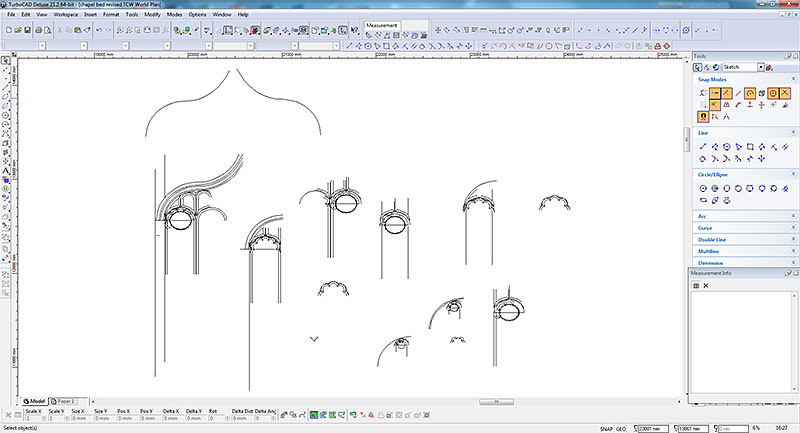
Preliminary stages of the ogee arched headboard inspired by Medieval rood screens.
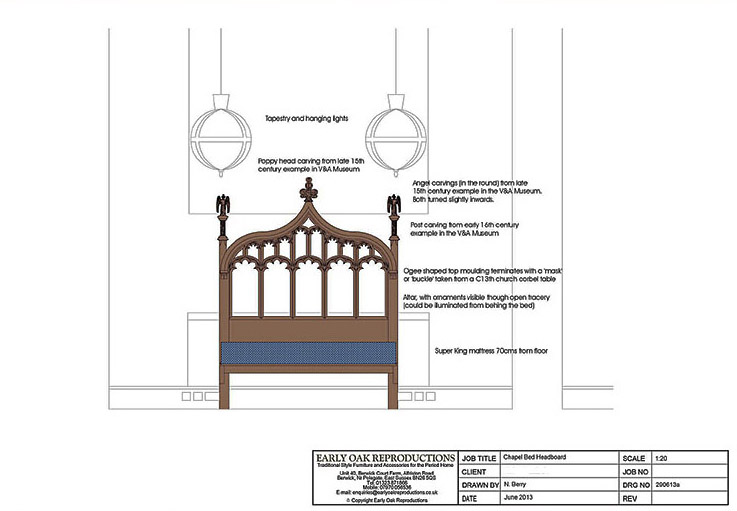
Oak bed head design, loosely based on a church rood screen, with cinquefoil arches and poppy head finial.
However, our client felt that the design was possibly a bit too ecclesiastical and so we further discussed keeping the open nature of the headboard, but simplifying the design, with a straight top rail in place of the ogee arch and then reproducing it, in a lower form, for the footboard (at this stage the footboard was just that - a horizontal board).
The diagram below shows the preparatory work for the modified design and demonstrates what often goes into getting everything right in terms of proportion, detail and build-ability of our furniture. An idea is put down on paper (well more correctly the monitor screen these days) and adjusted as necessary to achieve as near as perfect design. The beauty of CAD is that you can preserve the original and paste a copy next to it, which can be altered as required, copied and re-pasted, altered again and repeated if necessary. Having a number of alternatives, side by side, enables easy selection of the best of them. It's not unusual to end up going back to the first, but the exercise is well worth doing nevertheless, to explore all possibilities.
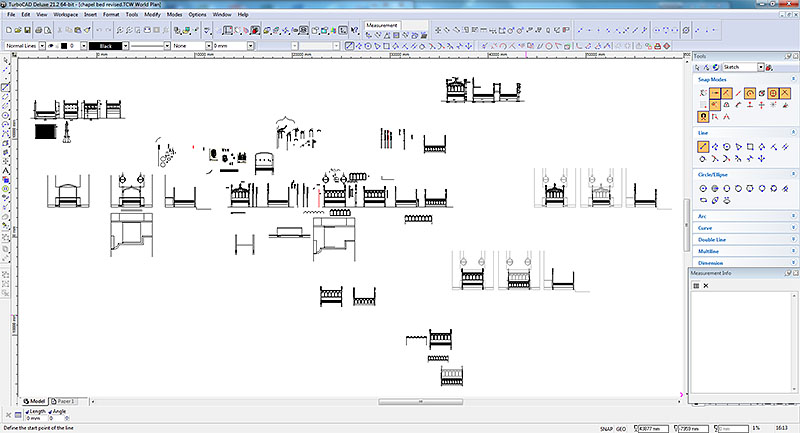
World plan (full size) preparatory CAD drawings for the revised oak chapel bed design.
The background to the design details.
This is probably a good time to discuss the various aspects of the bed's design details and the thinking behind the ideas.
In the case of what we refer to today as 'pencil beds' (as mentioned above), there is usually some kind of terminal decoration to the top of the posts. Now this could be something as simple as a stylized acorn or crocketed spire type finial, as in the photo below. However, being that we are furnishing a chapel, some further thought was needed for a more appropriate form of decoration.
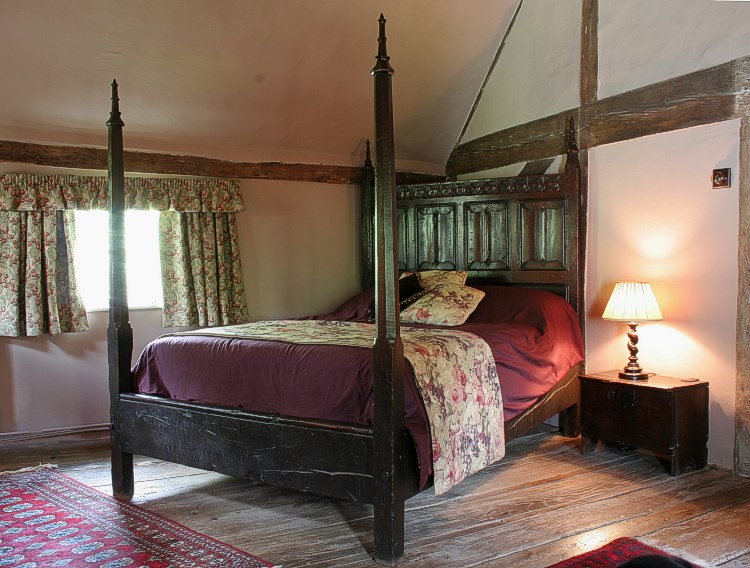
An early style oak bed, of what we now often refer to as a 'pencil bed', designed and handmade by our managing director, Nicholas Berry.
Rumour has it, that the room above the chapel, which was originally built as a bedroom, is haunted. If the story is correct, many years ago someone shot themselves during the night and later someone staying in the bedroom had an awful night and vowed never to go back there again. On at least one occasion the caretaker has heard the sound of gunshot coming from somewhere in the house. Having said that, nothing has been heard or seen in recent years. In the late seventies, a serious fire destroyed much of the house but, whether by divine intervention or the more likely efforts of the fire brigade at the time, the chapel was spared. In fact we believe that it was the only part of the house left intact. Apparently some of the firemen on that fateful night in 1979, saw the ghostly apparition of a monk, walking across the chapel and through the walls. We'll let you decide on the authenticity of that story...and the previous!
OK, so some or all of this may, or may not be, true, depending on your level of scepticism, or belief in the supernatural. Nonetheless, it does open up possibilities for some interesting design detail ideas.
The design detail.
So here's what we did:
On the top of the footposts, we incorporated two griffins, each facing slightly outwards for maximum 'viewing' angle. A griffin is a winged monster, having an eagle like head and wings, on the body of a lion. Its origins date back to before 3300 BC. Its purpose was to guard hidden treasures and for this it was admirably suited because of its strength and powers of sight (lion body, eagle head). On our 21st century bed, they are there to provide physical protection (metaphorically speaking of course) for the occupants. The basis of our carved oak griffins originate from Trinity College (which Trinity College we're not sure of - could be Cambridge, Oxford, Dublin, Bristol or London) and were modified by replacing the scale type wings with more a authentic feathered type.
For the actual foot post shafts, we took our inspiration from a small collection of 16th century posts in the V&A Museum Medieval collection.
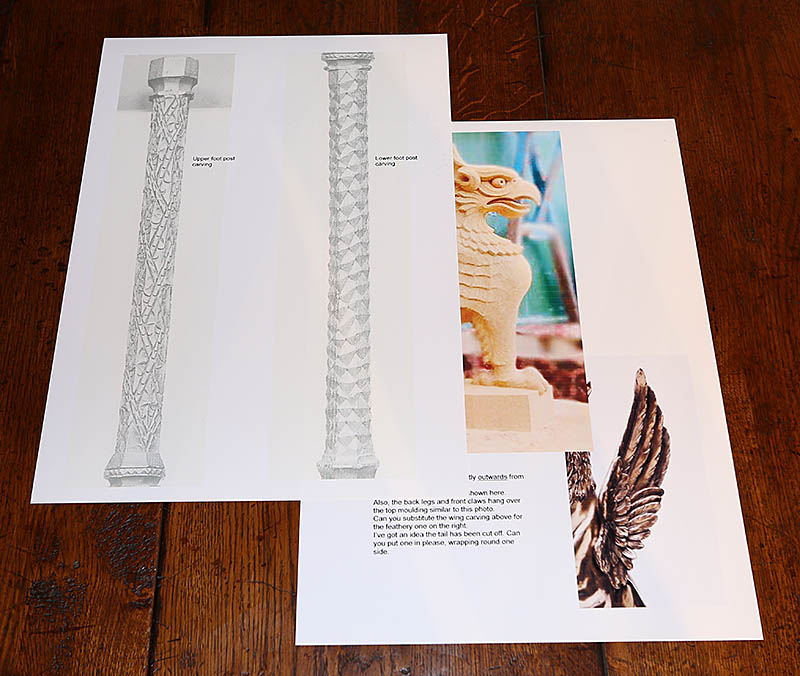
Reference images and workshop notes of the chapel bed foot posts, to accompany the CAD working drawings.
The headboard posts required a slightly different approach. Whilst the foot board posts supported the griffins for 'physical' protection, it was decided the headboard posts would offer a more 'spiritual' protection (metaphorically speaking again!), in the form of angels. Again, thanks to the V&A Museum, we were able to find the perfect example. An angel figure from the dismantled 15th century roof of St James church, Louth, in Lincolnshire (shown right in the photo below).
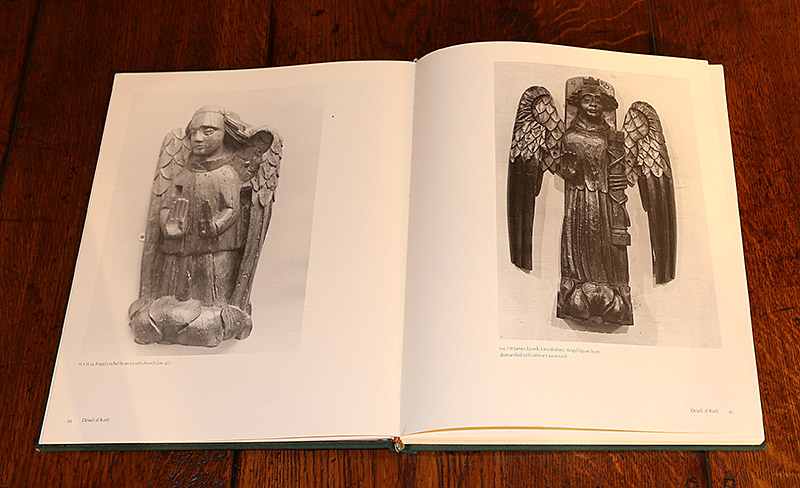
From the book published by the V&A Museum 'English Medieval Furniture and Woodwork'.
For the actual headboard and footboard framework, our client asked us to use the shape of one of the 14th century stone windows in his manor house.
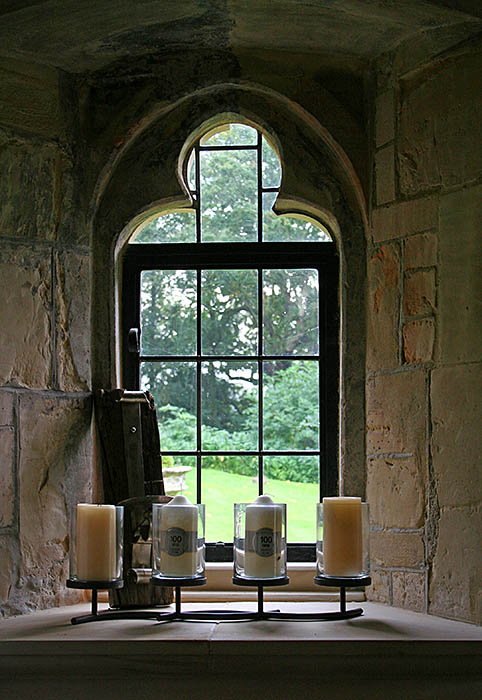
A typical Medieval trefoil arched window head, under a shallow lancet surround, provided the ideal shape (repeated linearly) for the bed head and foot board.
The design.
Having got the design details established, it was then a case of getting it all down on the CAD program (see the 5th photo above). Aspects to consider were:
a) Dimensions of mattress. In this case a bespoke-made 7ft wide affair.
b) Preferred height of mattress from ground and consequently depth of mattress.
c) Will the bed fit on the raised wooden stage. It was a bit tight lengthways (see below).
d) Where to start the headboard openings in relation to the altar height, bearing in mind b) above, plus pillows on top.
e) Where to finish the height of the headboard framework in relation to the tapestry hanging behind it.
f) How high to make the footboard posts, in relation to the mezzanine and having the griffins looking down at a standing person, when off the raised wooden stage.
g) How high to make the headboard posts, bearing in mind e) and f) above.
h) Proportions of every component, in relation to each other.
With all the above in mind (and possible much more we can't think of at the moment!), this is where all the brain work goes...
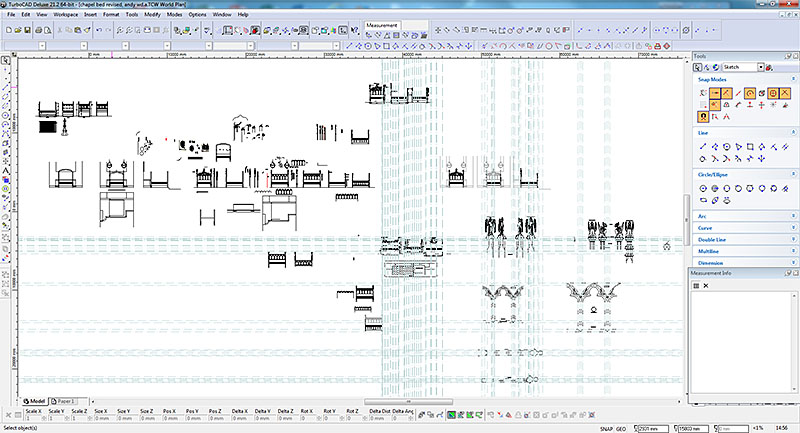
The coloured dotted lines are called construction lines and are used during the drawing's development.
...and this is how the next stage appears...
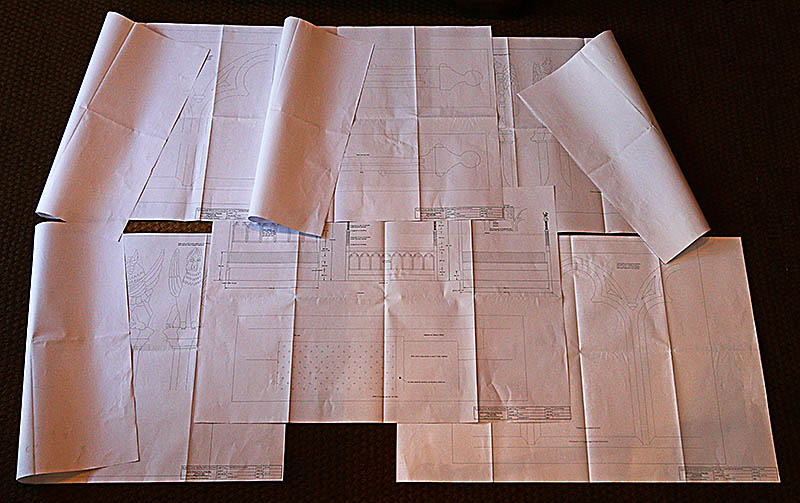
To scale and full size printed working drawings of the chapel bed and its components (a little bit creased and tatty round the edges, but they are working drawings!).
...and here are some details of the drawings...
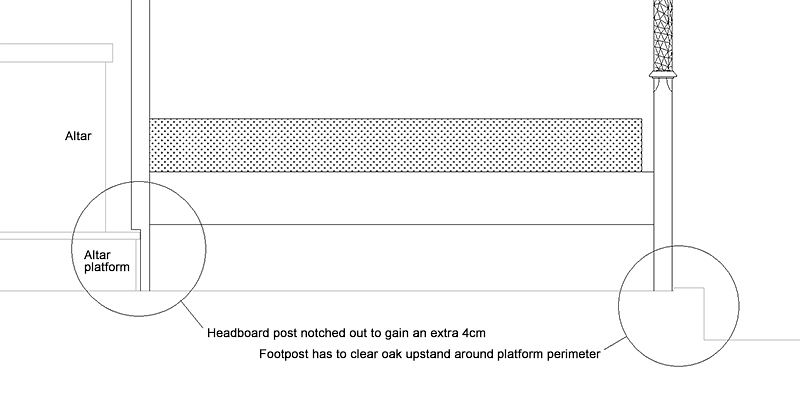
Detail showing how tight it was to get the bed inside the carpeted area of the altar stage.
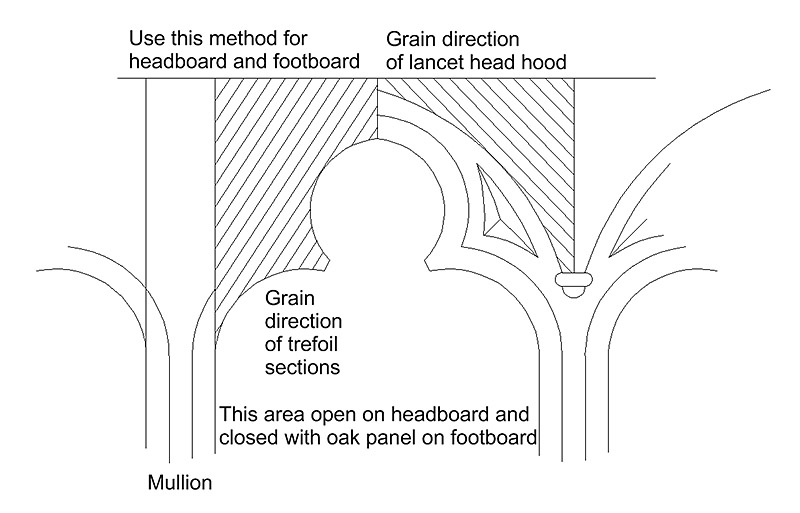
Part of the working drawing showing direction of grain in making up the trefoil tracery and lancet head hoods. A great example of Early Oak Reproductions attention to detail.
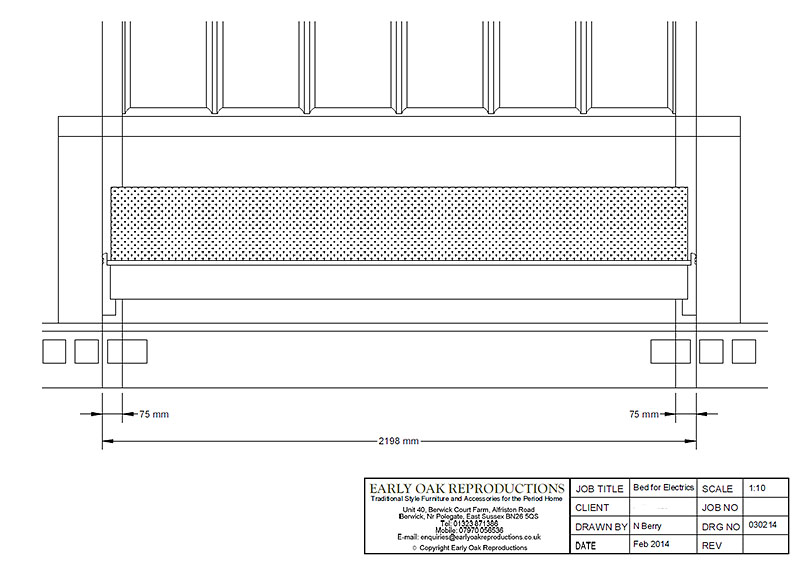
As you can see from the diagram above, the electrical sockets are partly obscured by the bed headboard posts. Being aware of this from the start we email this drawing to our client, so they could arrange to have the sockets moved inwards, so they would be easily accessible, but hidden under the bed.
The making.
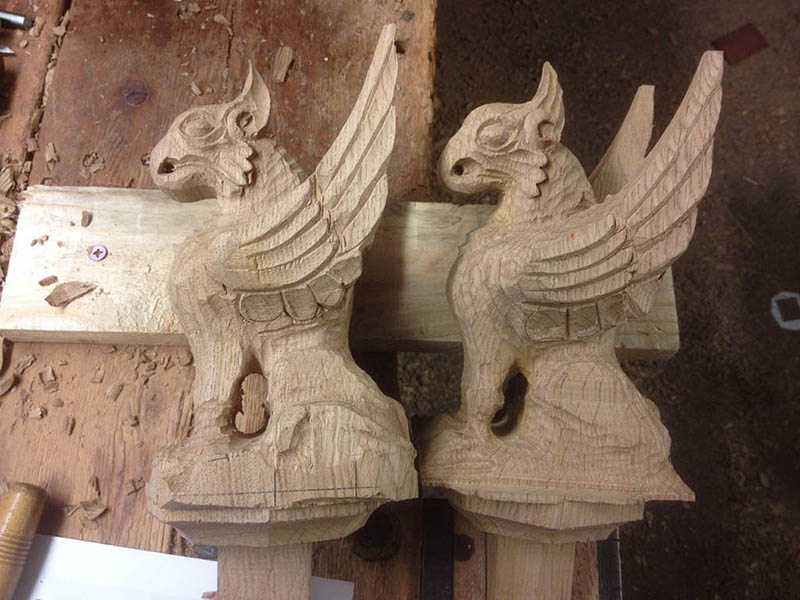
The two footpost oak griffins, partly carved.
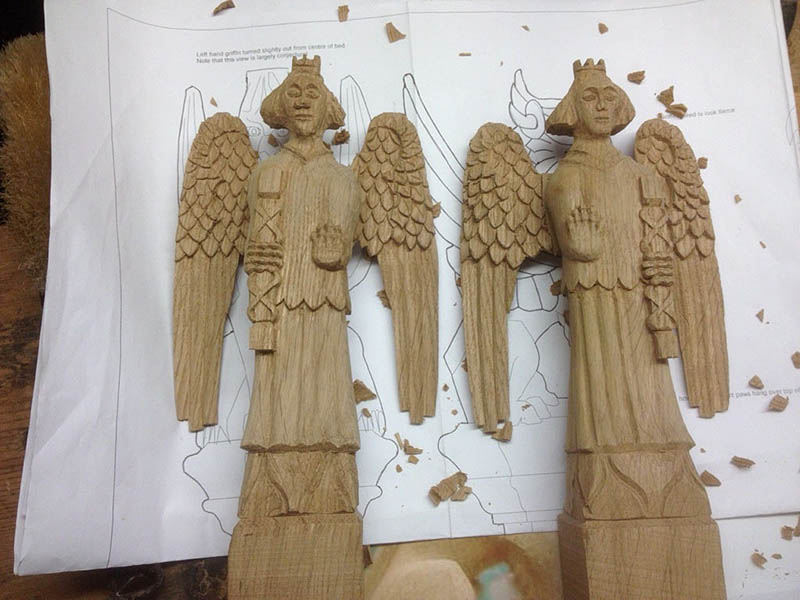
The two oak angels for the headboard posts, shown here partly carved.
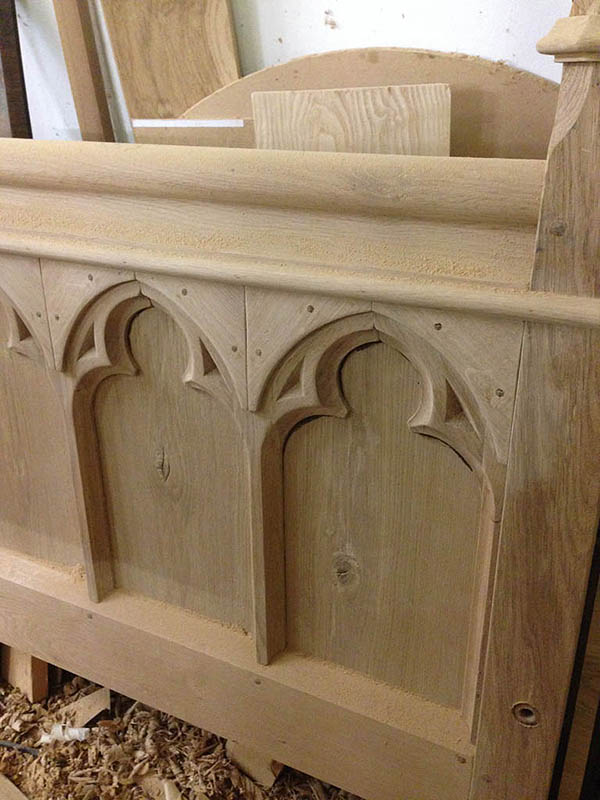
Detail of the footboard panels, with tracery carved trefoil heads and lancet-head cover panels (minus the little decorative dripstone style terminations). Note that the panels have had their edges stained before assembly, so as not to expose any pale oak edges, if the panels shrink back slightly.
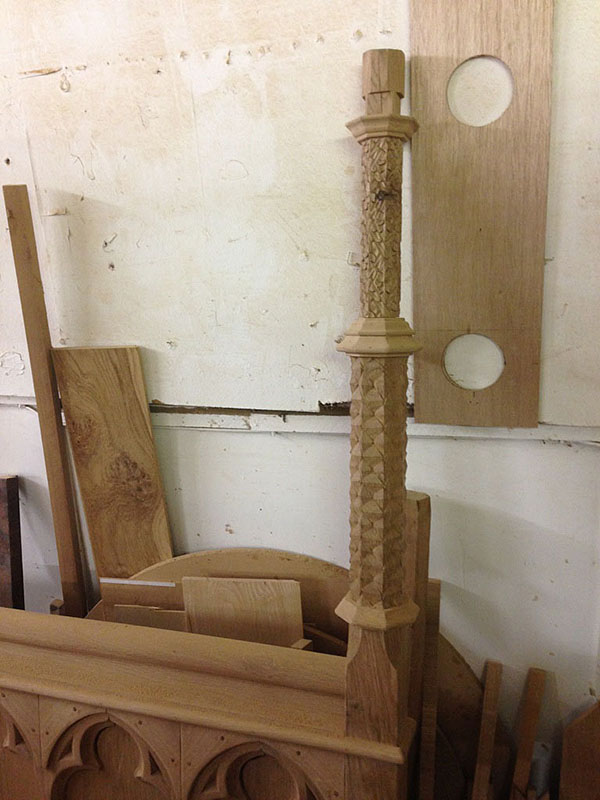
Detail of the Medieval style carved oak footboard posts.
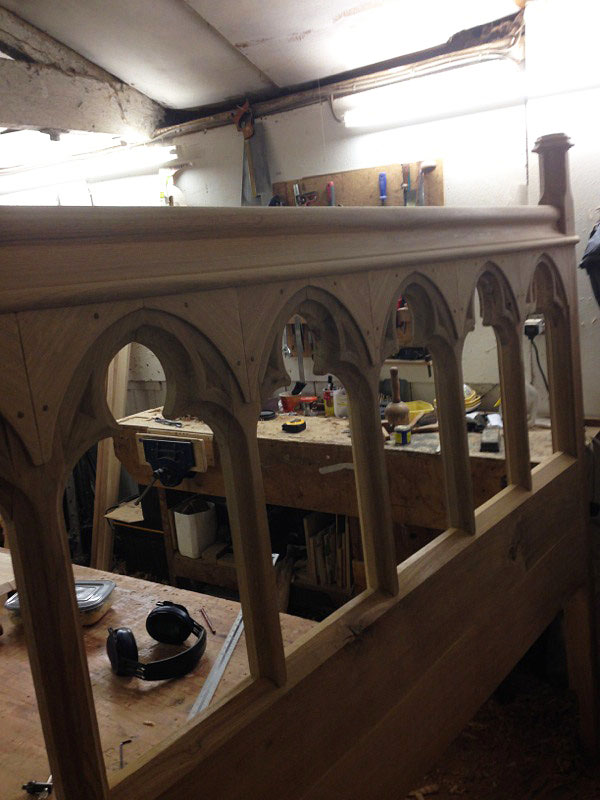
The open tracery of the headboard, during construction, prior to colouring ageing and polishing.
The finished bed in the chapel.
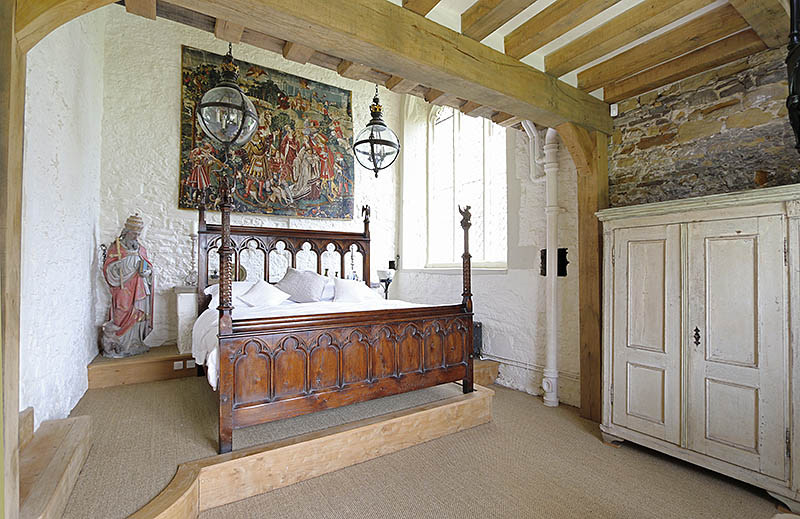
The finished bespoke designed Medieval style carved oak bed, in the 14th century chapel.
Further information.
To see the bed on our product page, together with more details and photos, click:
Late Gothic style oak carved bed for converted chapel.
To see more photos of this bed in our clients chapel, click:
Gothic style bespoke bed from hand carved solid oak.
Gothic style carved oak bed in 14th century manor house.
To see close up detail photos of this bed, click:
Gothic style period oak bed period moulding detail.
Gothic oak bed foot board detail.
Carved oak angel 15th century style.
Open oak tracery on Gothic bed headboard.
16th century style carved oak bed foot post.
Gothic style oak bed fixing bolt detail.
16th century style hand carved oak griffin.
All our prices include VAT and mainland England/Wales delivery. Details here of our UK and overseas delivery service
Easy to place your order and pay...
You can simply place your order here on our website by using our intuitive selection boxes (on any of our product pages) and then continue through to your basket page (you'll need to register with us first - see 'Login/Register'). You can email or phone us to pay for your order, or visit us personally at our showroom. Click here for contact details. We accept BACS transfer, cheque, credit card or debit card payments.
However you want to order, we've made it both straightforward and safe (see our accreditation's below).

This work is licensed under a Creative Commons Attribution-NonCommercial-NoDerivatives 4.0 International License.







